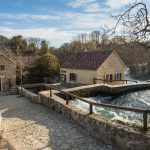The complex of watermills at Skradinski buk waterfall
The watermills at Skradinski buk waterfall, on the left and right banks of the river, represent an important testimony to the economic past of Šibenik and the Šibenik area, as they were a fundamental source for the economic power of the city.
The watermills at Skradinski buk waterfall were first mentioned in 1251 in a document by King Bela IV demarcating the territories of Šibenik and Trogir. During the 14th and 15th centuries, the mills on the Krka had great importance for the entire eastern Adriatic coast, because all the cities from Dubrovnik to Istria used them to grind grain. The existing mills at Skradinski buk were mostly built on the site of earlier mills. They have typical rural stylistic characteristics, which makes it difficult to date the buildings more precisely, but given the historical data, it is possible to date the current complex to the time after the end of the Ottoman threat in the late 17th and early 18th centuries. The walls of all the buildings are built of hard stone and travertine, bonded with a mortar made from a mixture of lime and sand or clay. The roof and mezzanine frameworks of the buildings are wooden, while the roof is made from curved terracotta tiles (formerly stone slabs).
The roads to the mills today are paved with irregular cobblestones. On the basis of the Austro-Hungarian cadastral map from the end of the 19th century, the ground plan situation with the corresponding names of the watermill complexes can be reconstructed.









The upper house mill complex consists of a house with a mill and a kitchen on the first floor, a miller’s dwelling, and a barn. The buildings are built of stone and travertine, with openings framed by stone sills. The wooden roof framework is covered with terracotta tiles. On the ground floor there is an area with six renovated mill wheels, and a drive mechanism (spoon-shaped paddles), while the first floor where there was a kitchen with a fireplace today is an exhibition space. Next to the mill is a preserved system for collecting water and six small channels through which the water was released for the millstones. In the extension of the mill is a pillar (for washing and softening cloth) and a basket (roller).
A small stone bridge with two arches leads to the complex of watermills called Živkuša and Kalikuša. The single story buildings of the mills were built of stone and travertine, with a two-eave roof covered with terracotta tiles. The mills used to be on the ground floor, with the dwelling of the miller above. The supply of water to the former drive mechanism (Kalikuša) of spoon-shaped paddles was through small channels. Behind the mill, the remains of a column hollowed into the rocks is accessible by stone stairs.
In the recent period, two more mills at Skradinski buk waterfall have been renovated, New House I and New House II, where a weaving workshop was set up.


